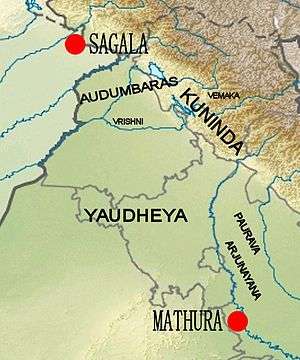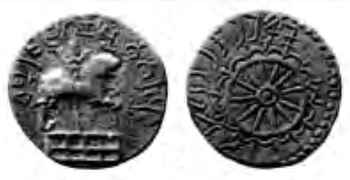Vrishni
The Vrishnis were an ancient vedic Indian clan who were believed to be the descendants of Vrishni, a descendant of Yadu. It is believed that Vrishni was son of Satvata, a descendant of Yadu, the son of Yayati. He had two wives, Gandhari and Madri. He has a son named Devamidhusha by his wife Madri. Vasudeva, the father of Krishna was the grandson of Devamidhusha.[3] According to the Puranas, the Vrishnis were residents of Dvaraka.


Obv Pillar with half-lion and half-elephant, surmounted by a Triratna symbol and surrounded by Buddhist railing. Indian legend Vṛishṇi Raja jnâgaṇyasya blubharasya
Rev Large Dharmachakra symbol. Arian legend Vrishni Raja jnâganyasya blubharasya.[1]
Migration of Vrishnis to Dvaraka
Jarasandha, father-in-law of Kamsa, invaded Mathura with a vast army; and though Krishna destroyed his army of demons, another asura, Kalayavan by name, surrounded Mathura with another army of thirty million monstrous fiends. Then Krishna thought it well to depart to Dwaraka.[4]
Vrishni Family Tree
The following chart shows the family tree of Krishna.[4][5][6]
| Vrishni♂ | consort♀# | ||||||||||||||||||||||||||||||||||||||||||||||||||||||||||||||||||||||||||||||
| Yudhajit♂ | consort♀# | ||||||||||||||||||||||||||||||||||||||||||||||||||||||||||||||||||||||||||||||
| Anamitra♂ | consort♀# | ||||||||||||||||||||||||||||||||||||||||||||||||||||||||||||||||||||||||||||||
| Vrishni♂ | consort♀# | ||||||||||||||||||||||||||||||||||||||||||||||||||||||||||||||||||||||||||||||
| Chitraratha♂ | consort♀# | ||||||||||||||||||||||||||||||||||||||||||||||||||||||||||||||||||||||||||||||
| Viduratha♂ | consort♀# | ||||||||||||||||||||||||||||||||||||||||||||||||||||||||||||||||||||||||||||||
| 4 generations | |||||||||||||||||||||||||||||||||||||||||||||||||||||||||||||||||||||||||||||||
| Hridika♂ | consort♀# | ||||||||||||||||||||||||||||||||||||||||||||||||||||||||||||||||||||||||||||||
| Devamidha♂ | consort♀# | ||||||||||||||||||||||||||||||||||||||||||||||||||||||||||||||||||||||||||||||
| Surasena♂ | consort♀# | ||||||||||||||||||||||||||||||||||||||||||||||||||||||||||||||||||||||||||||||
| Devaki♀# | Vasudeva♂ | Rohini♀# | Kunti♀ | 9 other sons♂ | 4 other daughters♀ | ||||||||||||||||||||||||||||||||||||||||||||||||||||||||||||||||||||||||||
| Krishna♂ | other sons♂ | Balarama♂ | Subhadra♀ | ||||||||||||||||||||||||||||||||||||||||||||||||||||||||||||||||||||||||||||
| Rukmini♀# | Satyabhama♀# | Jambavati♀# | Nagnajiti♀# | Kalindi♀# | Madra♀# | Mitravinda♀# | Bhadra♀# | Rohini♀# | 16,100 other wives♀# | ||||||||||||||||||||||||||||||||||||||||||||||||||||||||||||||||||||||
| Pradyumna, Charudeshna, Sudeshna, Charudeha, Sucharu, Charugupta, Bhadracharu, Charuchandra, Vicharu and Charu | Bhanu, Subhanu, Svarbhanu, Prabhanu, Bhanuman, Chandrabhanu, Brihadbhanu, Atibhanu, Shreebhanu and Pratibhanu | Samba, Sumitra, Purujit, Satajit, Sahasrajit, Vijaya, Citraketu, Vasuman, Dravida and Kratu | Vira, Candra, Asvasena, Citragu, Vegavan, Vrisha, Ama, Sanku, Vasu and Kunti | Sruta, Kavi, Vrisha, Vira, Subahu, Bhadra, Santi, Darsa, Purnamasa and Somaka | Praghosha, Gatravan, Simha, Bala, Prabala, Urdhaga, Mahasakti, Saha, Oja and Aparajita | Vrika, Harsha, Anila, Gridhra, Vardhana, Unnada, Mahamsa, Pavana, Vahni and Kshudhi | Sangramajit, Brihatsena, Sura, Praharana, Arijith, Jaya and Subhadra, Vama, Ayur and Satyaka | Diptiman, Tamratapta and 8 others | each wife had 10 sons and 1 daughter | ||||||||||||||||||||||||||||||||||||||||||||||||||||||||||||||||||||||
- The members born to the family are linked with solid lines (—)
- The wives of the male members are linked with dashed lines (--)
- Up to Surasena only the male members leading to the generation of Krishna are shown and other members are ignored.
- The individual male members shown in the chart are denoted by the symbol "♂".
- The individual female members shown in the chart are denoted by the symbol "♀".
- The female members who not born to the family but are related through marriage are denoted by the symbol "#".
- The sons of Krishna born to each of his eight princely wives are not shown separately due to their large number.
- The names of the children of Krishna born to each of the rest of his 16,100 wives are not mentioned.
End of the Vrishnis
After the death of Duryodhana in Mahabharata, Krishna received the curse of Gandhari. She bewailed the death of her son and of friend and foe; then recognizing Hari as the Prime Mover, the One behind All, she cursed him for letting such things befall. This was her curse: that after 36 years Krishna should perish alone miserably and his people, the Vrishnis, should be destroyed. These things in due time came to pass. A madness seized the people of Dwaraka so that they fell upon one another and were slain, together with all sons and grandsons of Krishna. Only the women and Krishna and Balarama remained alive. Then Balarama went to the forest, and Krishna first sent a messenger to the Kuru city, to place the city and women of Dwaraka under the Pandavas protection, and then took leave of his father; afterward he himself sought the forest, where Balarama awaited him. Krishna discovered his brother seated under a mighty tree on the edge of the forest; he sat like a yogi, and behold, there came forth from his mouth a mighty snake, the thousand headed naga, Ananta, and glided away to ocean. Ocean himself and the sacred rivers and many divine nagas came to meet him. Thus Krishna beheld his brother depart from human world, and he wandered alone in forest. He thought of Gandhari's curse and all that had befallen, and he knew that the time had come for his own departure. He restrained his senses in yoga and laid himself down. Then there came a hunter that way and thought him a deer, and loosed a shaft and pierced his foot; but when he came close the hunter beheld a man wrapped in yellow robes practicing yoga. Thinking himself an offender, he touched his feet. Then Krishna rose and gave him comfort, and himself ascended to Heaven. The hunter is said to be rebirth of Vaali from Ramayana who was killed by Rama by hiding behind a tree and was therefore given the opportunity to avenge in similar fashion by Rama himself.[4]
Arjuna went to Dwaraka and brought away the women and children of the Vrishnis, and set out for Kurukshetra. On the way a band of robbers[7] attacked the cavalcade and carried away a great part of women and children. The Gopas, Whom Krishna had offered to Duryodhana to Fight in his support when he himself joined Arjuna's Side, were no other than Yadavas themselves, who were also the Abhiras. Arjuna established the others with the remnants of Krishna's descendants in new cities; but Rukmini and many others of Krishna's wives became Sati, burning themselves on pyre, and others became ascetics and nuns. The waters of ocean advanced and overwhelmed Dwaraka so that no trace remained.[4]
Vrishnis in ancient literature
Pāṇini in his Ashtadhyayi (IV.1.114, VI.2.34) mentioned about the Vrishnis along with the Andhakas. The Arthashastra of Kautilya described the Vrishnis as a sangha (tribal confederation). In the Mahabharata (Drona Parva, 141.15) the Vrishnis and the Andhakas are referred as Vratyas.[8]
Vrishni coin

Alexander Cunningham found a unique silver coin of a King Vrishni (Raja Vrishni) which he identifies from the tribe of the Audumbaras, found in Hoshiarpur, Punjab.[1] This coin is at the British Museum, London. This circular coin has a sort of nandipada-standard-in-railing, a mythical animal, half lion and half elephant and a circular Brahmi legend Vṛṣṇirāja Jñāgaṇasya trātārasya on the obverse and an elaborate chakra of twelve spokes in pellet border with slightly truncated Kharoshthi legend Vṛṣṇirājaṇṇa(gaṇasa) tra(tarasa) the reverse.[9] Later a number of Vrishni copper coins were also discovered from Punjab.
References
- Alexander Cunningham's Coins of Ancient India: From the Earliest Times Down to the Seventh Century (1891) p.70
- Ph.D, Lavanya Vemsani (2016). Krishna in History, Thought, and Culture: An Encyclopedia of the Hindu Lord of Many Names: An Encyclopedia of the Hindu Lord of Many Names. ABC-CLIO. p. 296. ISBN 978-1-61069-211-3.
- Pargiter F.E. (1922, reprint 1972). Ancient Indian Historical Tradition, Delhi: Motilal Banarsidass, pp.103-7
- Sister Nivedita & Ananda K.Coomaraswamy: Myths and Legends of the Hindus and Bhuddhists, Kolkata, 2001 ISBN 81-7505-197-3
- "Krishna's visit to Prabhasa along with his family, Mausala Parva, Mahabharata - Kashiram Das". Archived from the original on 2013-12-12. Retrieved 2012-05-06.
- Family Trees, The descendants of Pururava.
- The Book of Yudhisthir: A Study of the Mahabharat of Vyas, from ... – Buddhadeva Bose – Google Books. 1986. ISBN 0861314603. Retrieved 14 June 2020.
- Raychaudhury, H.C. (1972). Political History of Ancient India, Calcutta: University of Calcutta, pp.126-8
- Lahiri, Bela (1974). Indigenous States of Northern India (Circa 200 B.C. to 320 A.D.), Calcutta: University of Calcutta, pp.242-3
